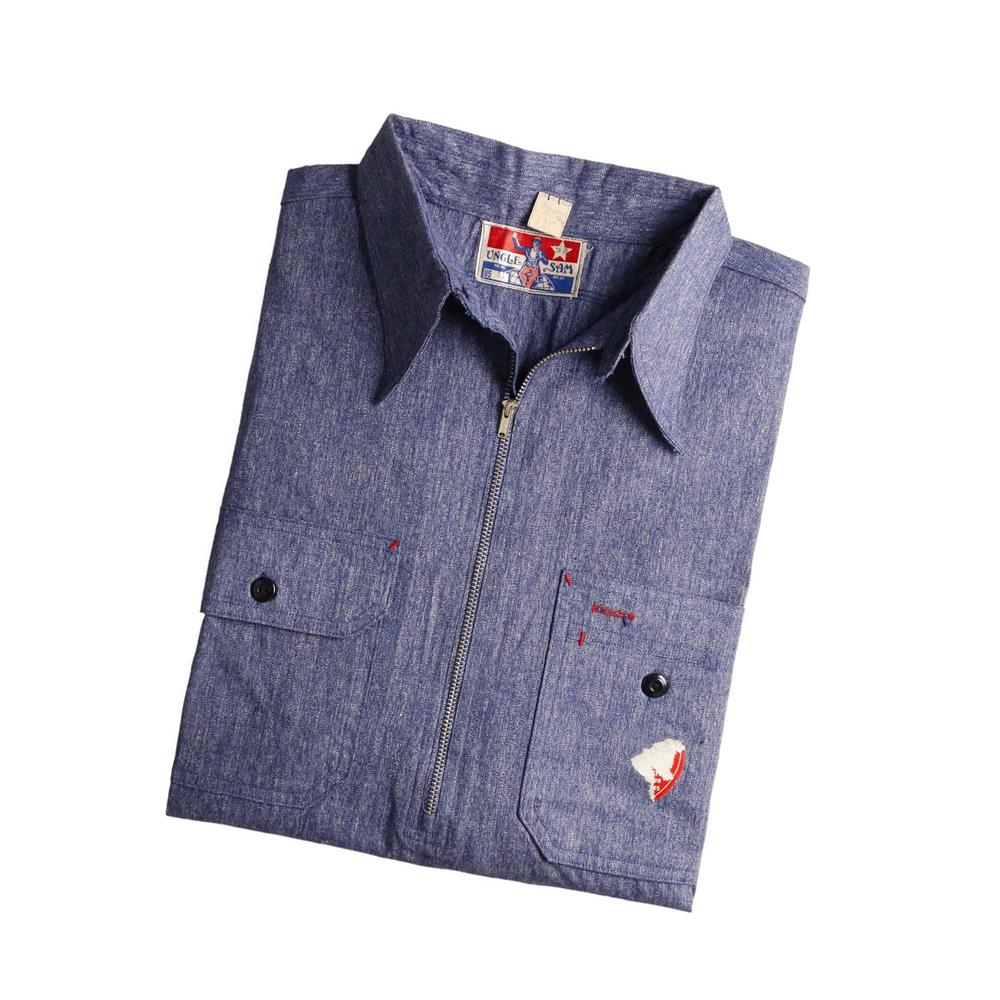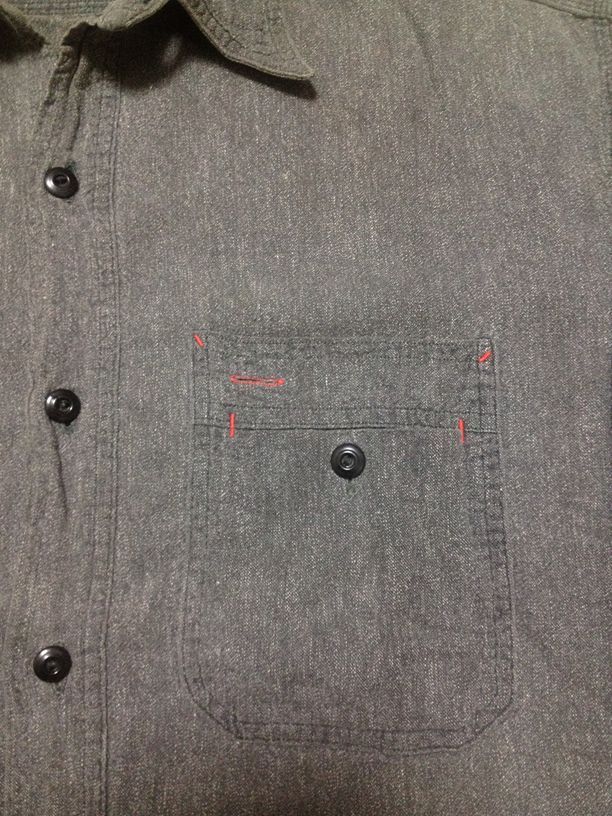
The Uncle Sam cigarette pocket shirt is one of the most iconic work shirt designs to emerge from the 1930s, not only for its look but also for its functionality. My path to recreating this shirt started not with the shirt itself but with an empty box: namely a vintage ‘30s or ‘40s box I acquired for one half dozen Uncle Sam shirts:


Of course I would have loved to have half a dozen of the shirts, but no luck. Then, about a year or so later, I did manage to snag one of the very same Uncle Sam shirts that would have been shipped to stores in this box, and here it is:


And here's yours truly wearing it, holes, fraying, stains, and all:

“What has it got in its pocketses?”
Excuse the Hobbit reference but the chest pocket design of this shirt is what drew me to it in the first place. It might be my favorite shirt pocket ever made. I love the way it looks, but I also appreciate how practical it is. It's the perfect size for holding my phone, wallet, and other essentials.

The pocket in question is a cigarette pocket-on-pocket patented for the Uncle Sam brand in 1937. It consists of two pockets, one smaller buttoned one on top of a large open-top one. Well, I’ll show instead of telling:

The point of the pocket-on-pocket, which was marketed as the patented E-Z Reach pocket, was for cigarettes, or loose leaf tobacco and papers, to go in the smaller front pocket. The extra fabric and space behind it would keep the tobacco dry from perspiration, similar in concept to the Big Yank Flyer and its various iterations with a ‘hanging’ small cigarette pocket:

More importantly to me was the large, open back pocket. I’ve come to find that during the course of the day I’ll try to throw all kinds of stuff into chest pockets, from my train card to car keys, eye drops, change, even eggs that I take from the fridge to the kitchen (seriously). While some of those things are better served going in pants pockets, I like having the shirt option. This pocket was everything I had subconsciously been reaching for; it can even hold my oversized smartphone in a pinch.
I happen to also enjoy the aesthetics of the pocket, so it was a win-win in my book. That’s not even mentioning the Uncle Sam shirt’s generous cut, triple-stitched main seams, and killer branding.

A brief history of Uncle Sam shirts
Where did the Uncle Sam shirt come from anyway? The above patent was awarded to one Arthur Lipshie and a Salant company so I dug a bit:
Salant & Salant Inc. of New York was founded in 1893 and trademarked the Uncle Sam work shirt brand in 1899. The brand was widely worn by US troops in World War I, according to a 1928 petition cancellation of a trade-mark registration that Salant & Salant filed against Feldman Weinman for their similarly named and marketed Sammy brand work shirts. That same legal opinion notes that Salant was reporting monthly sales of '4,000 dozen' (or 48,000) Uncle Sam work shirts during WWI and had reached monthly sales of up to 40,000 to 50,000 dozen (480,000 to 600,000) Uncle Sam shirts by 1928. These numbers plainly illustrate the scale and level of demand for work clothing in America at the time and how much greater it is than what any repro brand could ever hope to achieve today.

A Salant & Salant shirt factory in Portland, Michigan, 1935. Image courtesy of Portland Michigan History.
Salant factories like the one above, or those built in Tennessee, were putting out thousands of shirts a day. Fifteen thousand yards were cut daily by the pattern makers along with 50 cones of thread, or 15,000 yards worth of thread being used. Fabric was cut on two 216-feet long tables before going through 23 more steps with each part of the shirt being made by a different operator, including a multi-part rigorous steam pressing at the end.
Here is a 15-year service pin allegedly from the Lexington, Tennessee factory:

Image by way of eBay seller The Rusty Splinter
Up until the late 1910s, the Uncle Sam work shirt design went through seemingly two design iterations: the 1912 Sears Roebuck catalog it was a pullover with a single chest pocket:

Then in 1915 it was being sold in a version similar to my Atlas shirt but again in pullover form, as was still standard at the time:

A 1915 Charles William Store catalog listing for an Uncle Sam chambray work shirt; from my personal collection.
Here’s another example, a flyer I acquired that likely dates from the mid- to late-1910s and was probably distributed to stores to encourage them to stock Uncle Sam shirts:

Interestingly, this version it has the tallest sleeve plackets I’ve ever seen. Another aside: I’ve never seen an extant vintage example of the 1910s Uncle Sam shirts.
This promotional ruler made for Salant & Salant that sold on eBay most likely dates to the 1910s or ‘20s:



Here Salant listed separate Amoskeag shirts; it’s possible that they also used Amoskeag chambray for the Uncle Sam shirts.

Salant’s offices at the time were listed as 71 Worth Street, New York City, which is in the TriBeCa/Lower Manhattan area:

Getting better all the time
The early 1930s were a time of transition for Uncle Sam shirts; they were trying out various designs without finding a truly unique one just yet. For example, here are some from the early ‘30s, courtesy of Justin Steinke over at Solid Goods Vintage:

Uncle Sam shirts, “equal to government standard make”, here were offered in chambray, Tupelo madras, and black sateen, the latter two fabrics of which are rarely seen nowadays, even amongst repro workwear but which appear on the ruler mentioned above.

An Uncle Sam “Special”; I wonder, was this name given to other, non-standard designs? Here it is above in a scalloped yoke style ala the Milton F. Goodman shirt.

A semi-dress shirt this time, presumably because of the slightly fancier pattern on the chambray.
Then in 1936 one Arthur Lipshie filed the cigarette pocket patent we saw at the beginning of the article, which was granted the following year, for a new work shirt cigarette pocket. This would become the Uncle Sam signature design into the 1940s, and possibly slightly beyond.
Although I’ve found vintage examples of the shirt and patents, I’d never seen a photo of anyone wearing the Uncle Sam cigarette pocket shirt. That was until recently, though, when I finally found an early 1940s of a gentleman wearing an Uncle Sam shirt:

And with some colorization:

Dawn of the living shirt
As part of recreating this shirt I felt we had to get as many details dialed in as possible. For example, the original shirts at some point came with an ‘E-Z Reach’ sticker placed on the cigarette pocket:

So I had it reproduced but I made it a touch bigger:

Here’s another look at the original sticker on a pullover, zipper-front salt & pepper version of the shirt:

Image courtesy of Yahoo! Auctions Japan.
And a navy salt and pepper variant:

Image courtesy of Acorn Vintage.
Originals also sometimes shipped with ‘sanforized’ stickers, such as the one above. It’s clearer on this one posted by Waikiki Vintage:

The original buttons were a nice UFO/bowl shape, similar to the metal ones found on early 1930s Big Yank shirts:

Nobody was offering this shape off the rack so I provided an original button to Corozo Buttons in Panama and they were able to faithfully reproduce it in natural tagua nut:

Here you can more clearly see black versions of these buttons on a black salt and pepper version from the 1940s:

Image courtesy of the Workwear and More blog.
I have no evidence that a hang tag was placed on the original shirts, but I thought turning the box cover into a very sturdy hang tag would be appropriate:

Clearly this was a shirt design worth sticking with, which Salant did for at least a couple of decades, and which we've done our best to reproduce for you in our Uncle Sam shirt in indigo and tan.




What an incredible write-up and replication of a remarkable shirt! Are you going to have more made? I’d love to order a tan colored version.
Your website is very inspiring with high-quality content. We are sure that you will find additional useful information on our website. Come on, visit us at Konveksi Seragam Kerja and we can collaborate with each other.
Warm Regard.
So glad you did a history on these shirts. I’m certainly looking forward to getting mine!